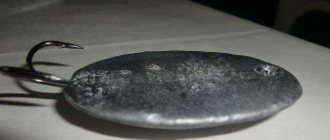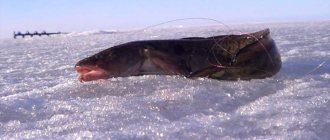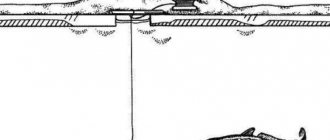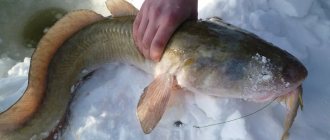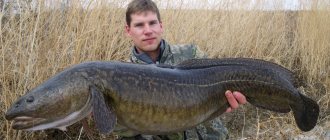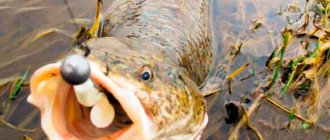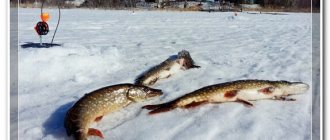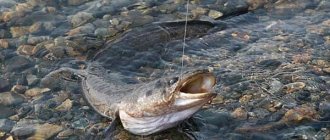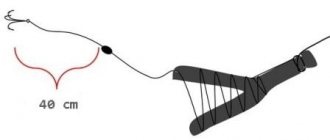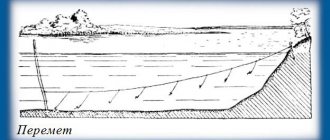The only freshwater representative of cod, burbot, is rarely encountered by spinning anglers. The peculiarities of the fish’s behavior lead to the fact that it is only occasionally found in bycatch, and very few anglers specifically go after burbot with a spinning rod. This is explained by sluggish biting during daylight hours, as well as other behavioral features. Such rare prey is a desirable trophy for a spinning fisher, so targeted fishing is still sometimes carried out, although the bycatch will often include pike perch, the night fishing of which is also popular and effective. Fishing for burbot with a spinning rod is also attractive because it shows maximum activity when other fish species are already preparing for winter - in late autumn, almost before the freeze-up.
Suitable spinning rod
Catching burbot with a spinning rod involves, first of all, fishing in the bottom layers of a reservoir, which means the best option would be jig . You need to select a fishing rod that meets not only the jig requirements, but also the fishing conditions.
the length based on the size of the reservoir and the distance of the points where fishing will be carried out. Since at night this representative of cod comes out to feed on the shallows located near the coastline, there is no need for long rods in such a situation. But conditions vary; places that are promising for fishing are often located at a considerable distance from the shore, which makes the use of forms 3 m or more long justified.
The action is preferable to fast or very fast, because fishing is carried out mainly with silicone, foam rubber baits or wobblers with deep depth, and less often with various types of spinners. Fast-action forms are best suited for these types of artificial baits, allowing the use of a wide variety of retrieves.
Test . This parameter also largely depends on fishing conditions and personal preferences. More often, burbot is caught on a spinning rod using relatively large baits, the length of which can be more than 9 cm, and eared sinkers or jig heads of the appropriate size will be needed for them. However, this is not a rule; you can successfully fish with ultralight, if such fishing is your favorite weight category in jig; autumn fishing can be effective using any weights.
It is also worth paying attention to the material used to make the handle - burbot is caught mainly in late autumn, which means that for fishing to be comfortable, the fisherman’s hands should not freeze to the rod.
A light and warm cork handle is considered the best option for such conditions. Important! In conditions of limited visibility, casting accuracy is important, and this parameter depends not only on the rod, but also on the angler’s ability to feel his tackle.
Photo 1. Set for spinning fishing.
Lure for winter burbot
Any artificial baits in this season are of little interest to burbot. However, in fairness, it is worth noting that sometimes burbot is still caught on a heavy spoon designed for winter pike perch or perch - but this is not the rule, but rather the exception to it.
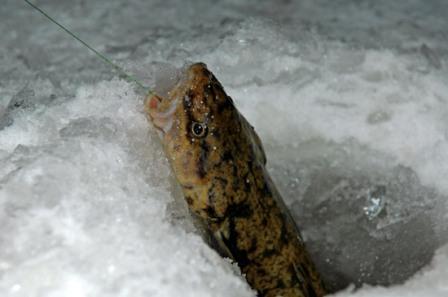
The most effective bait for burbot in the winter is small-sized live bait, and it doesn’t really matter in what form it is presented - the burbot will gladly take it dead or alive, since, in principle, it is omnivorous. Bleak, ruffe, gudgeon - these are the live bait that is most preferable for burbot, the main thing is that any of the above fish is found in a particular body of water where fishing will take place! It is also worth noting that during the period of active feeding, burbot takes well on frogs, shrimp and worms.
Coil selection
A spinning reel should be selected when the fishing rod has already been selected. For rods with a weight of 40, 50, or even 60 grams, you will need an equally powerful and reliable reel, which, although it will well withstand all the loads placed on it, will also cost a lot. When working with heavy weights, especially with frequent fishing, budget options may not withstand such operating conditions.
For working with smaller weights (up to 30g) and cords or fishing lines of the same average diameter, budget solutions are quite suitable. The load here is significantly less, which means that a meat grinder with internal mechanisms made of inexpensive materials can cope with the task assigned to it.
But in the lightest weight category everything is not so simple. With a line diameter of up to 0.4 according to the Japanese classification, budget reels work quite well, but as the diameter decreases, fishing ceases to be comfortable - beards and regularly dropped loops will ruin the whole fishing experience. Therefore, for ultra-thin braids, you will have to buy an expensive inertia-free wire that matches them in quality and cost.
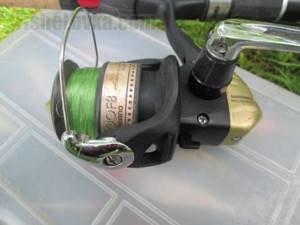
Photo 2. Reel from Shimano.
Using edible silicone
For fishing in the bottom layers of a reservoir using artificial baits, maximum attention should be paid to edible silicone and foam fish - these baits are most suitable for autumn spinning fishing. Autumn burbot fishing with a spinning rod places special demands on the quality of edible rubber. First of all, this concerns the behavior of silicone bait at low temperatures. The problem is that many budget silicone options work quite well in warm water, but when the temperature drops, they lose their softness, elasticity, and therefore their play. Therefore, you need to use products that have been tested in cold conditions, because the lower the water temperature becomes, the more actively the burbot feeds.
The color of the bait does not play a special role when fishing at night in autumn, although there are manufacturers that produce glow-in-the-dark options. But lovers of night fishing have not come to a clear conclusion about the light-accumulating elements on baits - some believe that they attract fish, while others believe that the glow only scares away aquatic inhabitants.
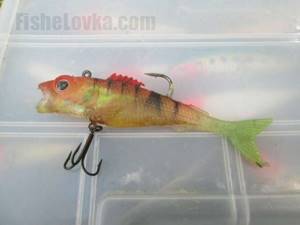
Photo 3. “Edible” fish.
When choosing silicone, preference should be given to active baits if you plan to fish at night, and take both active and passive options for daytime fishing. Daytime fishing in autumn becomes possible with the onset of the first night autumn frosts. At night, vibrations created by rubber are especially important - burbot does not see very well, especially at night, and relies more on the lateral line and sense of smell than on vision. This means it is better to choose baits that will be well felt by the side line - vibrotails, and to a lesser extent twisters. Passive rubber can also perform its task well, but the distance from which such silicone will be noticeable to burbot will be less than when using the same vibrating tails.
A wide variety of rigs can be used; often the option used depends more on the preferences of the fisherman. However, it is better to pay attention first of all to options that are less prone to snagging, since autumn fishing for burbot usually takes place in very difficult areas of the bottom.
Tackle for catching burbot in autumn
Donka rig for autumn burbot
Donka is one of the oldest and simplest fishing gear. It consists of a fishing line wound on a reel, at the end of which a weight and a hook are attached. The load is chosen depending on the strength of the current, which should not drag it strongly along the bottom. The hook is taken with a long shank and is large in size, so that it is easier to get it out of the predator’s mouth. One of the advantages of donks is that an unlimited number of them can be thrown into a reservoir, and at the same time, when not in use, wound on a reel, they do not take up much space. However, recently, most fishermen prefer to cast the bottom using a rod and reel, thanks to which the tackle can be thrown a considerable distance from the shore. Read also: For burbot with donka: gear arrangement and fishing subtleties
Installation of bottom tackle for burbot
Squealer for burbot and its equipment
Stukalka is a tackle for active fishing, reminiscent of a large jig. May look like a cone, pyramid, cylinder, etc. True, unlike a regular jig, several hooks can be installed on a jig at once for better grip. The tapping technique involves tapping the bait on the bottom. The sound of the blows attracts the attention of the burbot, and it attacks the bait. As additional bait, you can attach a fish, worm, or crayfish to the main hook. The bait is used for vertical trolling, so you can fish with it in a hole after the freeze-up begins or from a boat in open water. Read also: We figure out how to catch burbot using a snitch
Squealer for catching burbot: gear arrangement
Fishing for burbot in autumn
Another tackle as old as time for catching burbot in the fall is a seine. It consists of several hooks on leashes tied to a strong fishing line or cord. The hooks are baited with baits of animal origin - worms, live bait, larvae, frogs, shell meat, etc. A heavy weight is tied to the end of the cord. The tackle is thrown from the shore into the water or transported by boat. When fishing from the shore, it is better not to use gear with more than three hooks, since when casting, the leashes will get tangled, and live bait may fall off the hooks. When fishing from a boat or from ice, you can tie up to a dozen hooks, loading them with different baits.
How to set a line in the current! Let's catch Burbot, Chulym River!
Spoons, wobblers and foam rubber
With good fishing skills, you can catch burbot in the bottom layers using rotating or oscillating spoons. True, such fishing has a number of problems. The lure needs to be driven as close to the bottom as possible, and with such a drive, not all models retain the game, and the likelihood of a snag is high. Therefore, spinners are rarely used for autumn fishing.
Good results can be achieved by using wobblers with greater depth. Such baits are easy to recognize by their large blade. It is better to give preference to suspenders, since burbot prefers slow retrieves with pauses, but it is still advisable to have both sinking and floating models.
Simple baits such as foam fish can also be catchy. In addition to the seductive game, such a fish has several other advantages. Firstly, foam fish are easy to make and you can make them yourself in large quantities. Secondly, the catchability of the bait can be enhanced by impregnating the foam rubber with an artificial or natural flavor. Thirdly, you can reduce the number of hooks by simply hiding the hook tips in the bait itself.
Important! When fishing at night, it is advisable to have a supply of batteries for flashlights, since in cold weather the batteries discharge faster.
Tackle with dead fish
The effectiveness of such natural bait is especially high when predatory fish behave passively. The tackle is a fairly simple wire structure that secures a dead fish. Such a structure is loaded with an ordinary eared sinker. The hook used, as a rule, is one treble (although sometimes more hooks are used), which is threaded into the side of the fish with one of the stings. This design is carried out as slowly as possible so that the predator has time to smell the smell.
The tackle is often used in situations where the predator ignores other baits.
Important! If the fish is fresh, just caught, its attractiveness to a predator can be increased by making several cuts on the side - predatory fish smell blood from a great distance.
Fishing place
Unlike the same pike perch or pike, finding burbot without knowing exactly its stopping and feeding places is extremely problematic. In the case of this fish, search fishing brings good results relatively rarely. Before going out specifically for burbot, you must either already have successful fishing experience in this place, or have fairly accurate information obtained from familiar anglers. Traces of fires on the shore can also serve as a guide to finding a fishing spot (unless it is a favorite picnic spot).

Photo 4. Autumn river.
If we talk about the places where burbot most likely lives, these will be rivers with clean water and constant recharge from cold springs. This fish prefers a rocky bottom, as it is easier to find shelter on it. Burbot can also be found in places where the roots of trees from a steep bank go under the water - this is also a good shelter for this fish. When fishing at night, you should pay attention not to the burbot’s camp sites, but to the shallows located not far from them, where the fish come out to look for food when night comes. If fishing takes place in late autumn, when the air temperature is already close to negative values, you can find burbot in almost any part of the reservoir - the fish is preparing for spawning, it has a glutton.
Fishing Features
Spring burbot fishing involves a wait-and-see approach. The fisherman selects a promising place, examines it, determines the required casting distance and the weight of the equipment. All that remains is to arrange the gear and wait for the predator to come out.
In early spring, bitterly cold weather with biting winds often prevails. On sunny days you shouldn’t count on a bite. Burbot sits in shelter and goes out hunting at night. When it is cloudy, the predator can peck both at lunchtime and in the dark.
It is advisable to simultaneously place two or three tackles, on the hooks of which different baits are attached. They are cast at short, medium and long distances, trying to cover the water area as completely as possible so that the predator is sure to find the bait.
If there are no bites, you need to transfer the tackle once every hour and an hour and a half. It is enough to check and, if necessary, refresh the bait by changing it. If the burbot took prey but spat it out, you should reel out the fishing line. It is necessary to double-check the integrity of the bait and put it back into the water.
The bite of this representative of cod fish is confident. He immediately takes the bait, quickly swallows it and moves on. Once hooked, it provides moderate resistance. The fish does not make sharp jerks like a pike, but presses down, trying to press down to the bottom and go to the nearest shelter.
We recommend reading: Catching pike perch in winter using girders
Catching burbot in early spring in muddy water
The predator begins to peck at the donkeys immediately after the rivers open. However, after 2–3 weeks, the level in the reservoir gradually rises, the current washes away debris and branches from the banks, carries down dirt, and lifts silt from the bottom. Therefore, it is difficult to catch fish in muddy water, since it becomes passive and moves from its usual places.
In early spring, it is easier to find burbot in areas where the water is relatively clean, and the dirt raised from the bottom does not clog its gills, preventing normal life activity. The main fishing places during this period:
- pockets and pools with medium depths;
- in the area of river bends;
- behind islands, capes;
- among large single flooded trees and trunks.
Despite all the difficulties of the period when the water in the river rises, it is possible to catch burbot. The fish still continues to feed when it gets hooked.
Fishing in April and May
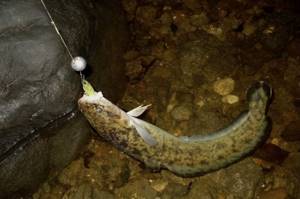
Fishing for burbot in mid- and late spring is not fundamentally different from fishing at the beginning of the season. It is important to understand here - the hotter the water warms up, the more passive the predator becomes and bites less often.
Good results are shown by bottom gear, especially the bait-and-dash bait, feeder and cargo. The first two methods are relevant at medium and long distances, the last method is suitable for close-range fishing along a flooded line or coastal edge.
Spinning is also suitable for hunting burbot. But you won’t be able to target just this predator. The method is universal and therefore more interesting than donka. When fishing with artificial baits, pike perch, perch, pike, catfish and asp are likely to bite.
Tactics and postings
Tactics depend primarily on the time of day. If you are fishing at night, then first of all you should fish shallow waters near the burbot’s camp sites. If fishing takes place during the day, then it is better to pay maximum attention to fishing for the burbot’s favorite hiding places - deep-sea rocky areas of the bottom, holes with cold springs at the bottom. Although, if the activity of burbot has increased with the cold weather, this fish can be found in any part of the reservoir.
You can and even need to make a fire on the shore. It will not only allow frozen fishermen to warm up, but will also attract burbot to the fishing spot with light. It was noticed that when fishing in autumn, the worse the weather, the higher the likelihood of an active bite and a good catch.
Autumn fishing for burbot should be as slow as possible (especially when fishing at night), with long pauses. You can also slowly drag the bait along the bottom. During a pause, it’s a good idea to give the bait additional vibrations with the tip of the spinning rod.
What to use to catch burbot in the fall
Burbot is a predatory fish, which means the bait must be appropriate. In September, it won’t be much of a problem to catch live bait near the shore, collect shells at the bottom, catch baby frogs and other living creatures. However, with each new autumn day, when the weather deteriorates, the air becomes colder and the water cools down, this will be very problematic. In this case, several dung or earthworms, frozen fish, squid, shrimp, bird giblets, maggots, etc. can be used as bait. Fans of active fishing can try their luck with a spinning rod, using oscillating spoons or silicone as artificial bait.
